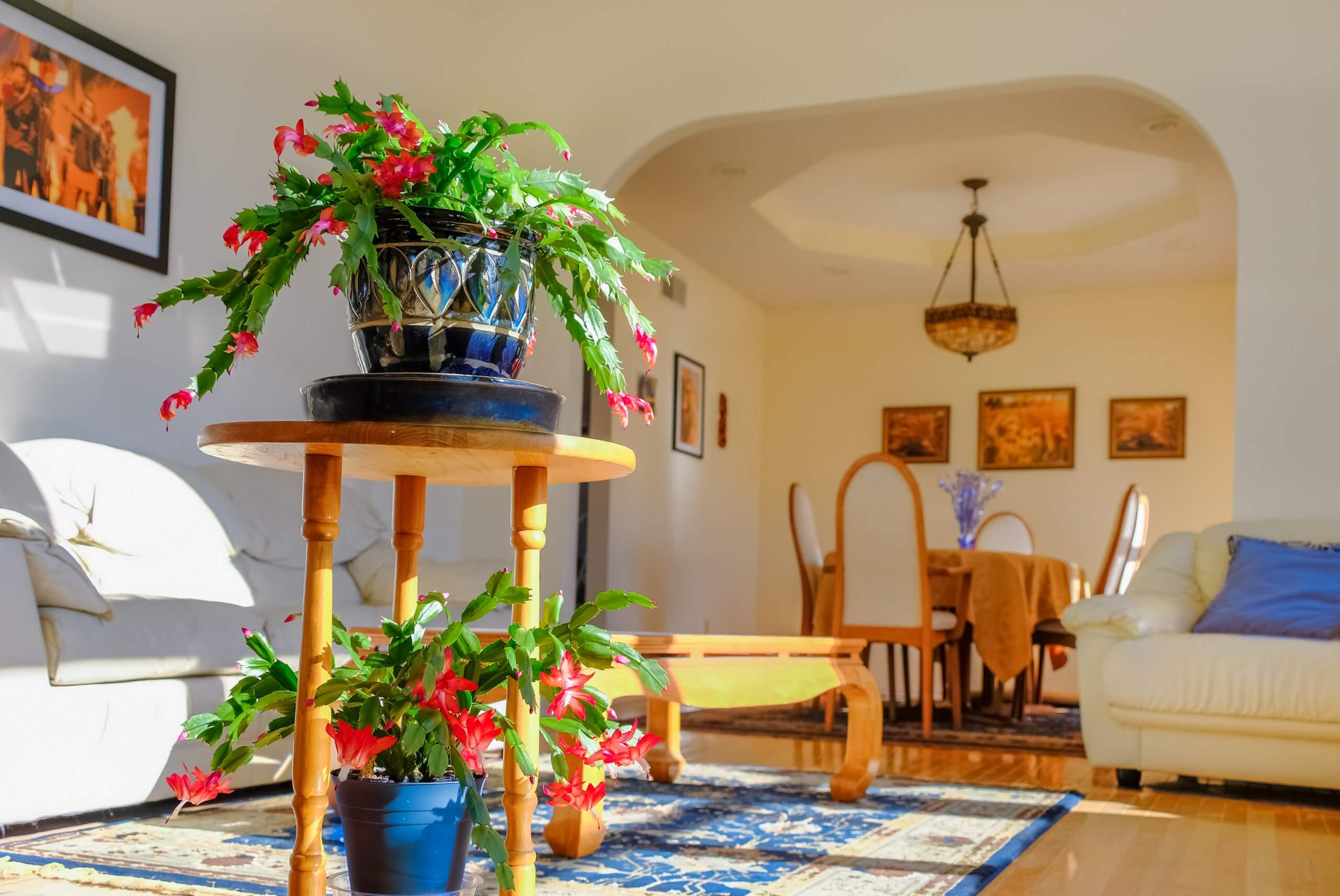Why Is the 40–60% Range Ideal?
When indoor spaces are extremely dry or humid, it causes discomfort and health issues, and can even compromise the structural integrity of your home.
As with most things in life, there is a happy medium. For ideal home humidity, the ideal comfortable humidity level range is 40 and 60%.
What Is Low Indoor Humidity?
When your home’s humidity falls below 40%, it is considered a low humidity level. Low indoor humidity is more common during the winter season, particularly in regions that regularly experience freezing temperatures and snowfall. A lack of humidity in the air has health impacts, causing dry skin, lips and eyes, itchiness and a sore throat.
Low humidity in the house can have a significant effect over time. As humidity decreases, wood materials such as floorboards will warp or shrink and wallpaper may start to peel. In extreme cases, gaps will form between the boards and the wallpaper could completely fall off.
Low humidity can also cause the paint to chip, furniture and fabrics to dry out, static electricity buildup, increased dust levels throughout your home, and itchy skin and sore throats for its inhabitants.
It is essential to monitor humidity levels in order to prevent further damage from occurring.
Common symptoms of low humidity in the house:
- Bloody noses
- Chapped or cracked lips
- Dry, itchy skin and eyes
- Cold-like symptoms
- Itchy or scratchy throat
- Dry, cracking wood
- Static electricity
- Allergy and asthma flare-ups
 Whole-Home Humidifiers We Recommend: We know how important it is to make sure you’re choosing the best product for your needs. That’s why we have a dedicated information page on whole-home humidifiers, with specific details about each available type! Consult with a local IAQ expert before any final decision or major purchase. Learn more here →
Whole-Home Humidifiers We Recommend: We know how important it is to make sure you’re choosing the best product for your needs. That’s why we have a dedicated information page on whole-home humidifiers, with specific details about each available type! Consult with a local IAQ expert before any final decision or major purchase. Learn more here →
What Is High Humidity In A House?
When the house humidity level rises above 60%, it’s considered high. High indoor humidity levels are common during summer, particularly in regions like the South that experience high outdoor humidity. When the air in your home is too humid, it poses serious health risks for you and your family. Respiratory symptoms worsen in overly humid spaces. For those with existing conditions, asthma or allergies, humidity control is particularly important.
High humidity in the house also has a terrible effect on the structural integrity. It creates condensation on windows, promotes mold growth, produces a foul or muggy odor, draws in insects and gives the air an overall moist, sticky feel.




What Is The Best Humidity Level For A Home?
The happy medium for relative indoor humidity is 40–60%.
You may find research that suggests the 30–50% range is ideal for indoor spaces. That is primarily considered an outdated suggestion, thanks to current research.
The appropriate range for indoor humidity levels is 40–60%. This range promotes comfort, health and excellent air quality.
Look at the ideal indoor humidity chart below to better understand the pros and cons of each atmosphere! And see which conditions, symptoms and organisms thrive in different indoor humidity levels.
| Below 40% | 40–60% | Above 60% | |
|---|---|---|---|
| Allergies | ✔ | ✖ | ✔ |
| Asthma | ✔ | ✖ | ✔ |
| Respiratory Illnesses | ✔ | ✖ | ✖ |
| Viruses | ✔ | ✖ | ✖ |
| Bacteria | ✔ | ✖ | ✔ |
| Dust Mites | ✖ | ✖ | ✔ |
If your home’s indoor air is unregulated, it can help enable the spread of viruses and bacteria.
High or low humidity in the house can also exacerbate existing respiratory symptoms, allergies, asthma and increase your chances of catching a common cold or flu. Additionally, air that is too dry or humid is generally uncomfortable to live in.
Read more →
How To Achieve Ideal Indoor Humidity In Your House

If the humidity levels in your home are too low, consider using a whole-home humidifier. A humidifier adds moisture to the air. This effectively ends the dry winter season in your home while also creating a warmer atmosphere.
Other tips and tricks to increase humidity:
- Cook without lids
- Shower or bathe with the bathroom door open
- Purchase houseplants

If the humidity in your house is too high, consider using a whole-home dehumidifier. This system removes excess moisture from the air.
Other tips and tricks to decrease humidity:
- Use a range fan when cooking
- Shower or bathe with cool water
- Ventilate the bathroom after showering or bathing
- Remove houseplants
In order to maintain a comfortable and healthy home, it is essential to monitor indoor humidity and make adjustments. The benefit of opting for a whole-home humidity control system? It will automatically measure indoor humidity levels and make the necessary adjustments so the level in your home remains between 40–60%. And it does so without ever causing a worry! Whole-home humidifiers and dehumidifiers will set your space up for the perfect indoor humidity range.
Comfortable Humidity Level and Healthy Indoors
We can all agree that a home is more comfortable when the risks of illness, dust mites and furniture damage are low. In addition to trying the helpful tips and tricks mentioned, consider upgrading to a whole-home humidity control solution.
It can be tricky to determine if home issues are due to high or low humidity levels. This is why it’s important to find an experienced IAQ expert who can help determine the problem and advise on the best system for your home.
 Air Conditioner vs. Dehumidifier: The truth is, an AC unit can’t do much for dehumidifying indoor air—it just blows cold air around rather than removing excess humidity like a dedicated dehumidifier can!
Air Conditioner vs. Dehumidifier: The truth is, an AC unit can’t do much for dehumidifying indoor air—it just blows cold air around rather than removing excess humidity like a dedicated dehumidifier can! Read more →
Best Humidity Level for Sleeping
The best humidity level for sleeping is between 40–60%. This range of humidity is optimal for comfort and restful sleep. Maintaining a humidity level in your bedroom at this range will prevent your skin from drying out and not feeling too hot or cold at night.
Having a thermostat set to 65 degrees Fahrenheit is also necessary for maximum comfort while sleeping, as it mimics the natural drop in body temperature during sleep.
Keeping the indoor humidity level at 40–60% and the temperature at 65 degrees can help create an atmosphere conducive to restful sleep.
What Humidity Level is Uncomfortable
While 40-60% range as ideal for indoor humidity, it’s essential to understand the discomfort that can arise outside this range.
Below 30%: The air can feel unnaturally dry at extremely low humidity levels. This can exacerbate respiratory conditions and can lead to frequent static shocks. Moreover, musical instruments, especially those made of wood, can get damaged as the wood contracts.
Above 70%: The air can feel stifling and suffocating at very high humidity levels. It can lead to excessive sweating, even without physical exertion. Moreover, electronic devices can be at risk as excessive moisture can lead to condensation inside them.
In both scenarios, our body’s natural cooling mechanism, which is sweating, gets disrupted. In low humidity, we might not feel the need to sweat, leading to overheating, while in high humidity, the sweat doesn’t evaporate efficiently, making us feel hotter than the actual temperature.
Indoor Humidity FAQ
Yes. As explained in this article, the appropriate range for indoor humidity is 40–60%. This range promotes comfort, health, and excellent air quality.
The ideal indoor range is between 40–60%. This level will make a house feel warm and cozy, dry out any moisture build-up or mold issues, as well as improve respiratory health by boosting indoor circulation!
How to take control of your home’s winter season humidity levels ➞
If you have a problem with humidity in your home, it is best to resolve the issue rather than relying on fans. A fan can play an important role and help mitigate some excess moisture effects, but ultimately you should consider a more permanent solution.
Yes. The standard for indoor humidity is between 40–60%. When indoor humidity falls below this level, it can harm those who live in the home.
Opening your windows is a great way to dry out the air in your home, assuming outdoor humidity levels are lower. However, don’t open windows when the AC is running or the AQI is poor.
Learn how to control your home’s humidity levels ➞
The normal humidity levels in a house can vary and depend on several factors, such as the local climate, home design, and the equipment used to regulate the air quality.
The ideal humidity range for a home should be between 40% and 60%, as anything outside of this range could lead to several problems such as respiratory discomfort, dry skin, and eyes, or even mold growth. Having too much humidity in your house can cause dust mites to thrive while having too little humidity can increase static electricity.
Monitoring the humidity levels in your house is vital to ensure that you are able to prevent any potential problems associated with indoor air quality.
The optimal environment for sleeping would be neither too humid nor too dry—somewhere in the ideal range of 40-60%. Additionally, it is essential to maintain a comfortable temperature (ideally 65 degrees) for an ideal sleep experience.
The ideal indoor humidity level for sinuses is in the range of 40-60%. This humidity level helps keep the mucous membrane in one’s nose and sinuses moist, which can help reduce congestion, sneezing, and itchy eyes. Individuals with allergies or asthma should consult a doctor before making significant changes and get professional advice.




